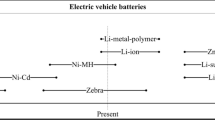Abstract
It is important to choose an efficient cooling method for thermal control of lithium-ion battery system, so that these strategies should provide cost worthy solutions of energy saving for rise in temperature of the system during the operation of battery. Battery is one of the main parts of electric vehicles and as compared to other batteries like lead-acid, nickel-cadmium, etc., lithium-ion batteries are receiving more attention of automobile industries and other industries due to its high energy density, power density, voltage, life cycle, and low self-discharge rate of energy. The heat generation within the Li-ion battery reduces its performance and life of battery as well. This paper investigates the thermal control of the battery using air, water, and graphene (0.4%)-water nanofluid as coolant having thermal conductivities of 0.0242, 0.60, and 0.6203 W/m·K. In this paper, the NTGK method is used to simulate the thermal analysis of Li-ion batteries under the MSMD model of a battery in ANSYS Fluent. The simulations have been carried out for estimating the maximum temperature of the battery under different velocities of fluid using air, water, and nanofluid coolants. The result shows that the maximum temperatures 308.782, 302.734, and 300.656 K have been obtained after cooling with air, water, and nanofluid with flow velocities of 20, 0.01, and 0.015 m/s. After comparing the maximum temperatures obtained after using different coolants, it is found that nanofluid reduces the maximum temperature more as compared to air and water.
Access this chapter
Tax calculation will be finalised at checkout
Purchases are for personal use only
Similar content being viewed by others
References
Choudhari VG, Dhoble AS, Sathe TM (2020) A review on effect of heat generation and various thermal management systems for lithium ion battery used for electric vehicle. J Energy Storage 32:101729
Xia G, Cao L, Bi G (2017) A review on battery thermal management in electric vehicle application. J Power Sources 367:90–105
Jayamohan D, Venkatasalam R, Thangam C (2022) Experimental analysis of thermal behavior of a lithium-ion battery using constant voltage under different cooling conditions. Int J Electrochem Sci 17(220810):2
Chen D, et al (2016) Comparison of different cooling methods for lithium ion battery cells. Appl Therm Eng 94:846–854
Duan X, Naterer GF (2010) Heat transfer in phase change materials for thermal management of electric vehicle battery modules. Int J Heat Mass Transf 53(23–24):5176–5182
Bandhauer TM, Garimella S, Fuller TF (2011) A critical review of thermal issues in lithium-ion batteries. J Electrochem Soc 158(3):R1
Sefidan AM, Sojoudi A, Saha SC (2017) Nanofluid-based cooling of cylindrical lithium-ion battery packs employing forced air flow. Int J Therm Sci 117:44–58
Tousi M et al (2021) Numerical study of novel liquid-cooled thermal management system for cylindrical Li-ion battery packs under high discharge rate based on AgO nanofluid and copper sheath. J Energy Storage 41:102910
Bhagat VK, Paswan MD (2022) Thermal management analysis of a lithium-ion battery cell using different coolant. J Phys Conf Ser 2178(1) (IOP Publishing)
Malik M et al (2018) Thermal and electrical performance evaluations of series connected Li-ion batteries in a pack with liquid cooling. Appl Therm Eng 129:472–481
Sheikholeslami M, Rokni HB (2017) Simulation of nanofluid heat transfer in presence of magnetic field: a review. Int J Heat Mass Transf 115:1203–1233
Jaguemont J, Van Mierlo J (2020) A comprehensive review of future thermal management systems for battery-electrified vehicles. J Energy Storage 31:101551
Author information
Authors and Affiliations
Corresponding author
Editor information
Editors and Affiliations
Rights and permissions
Copyright information
© 2023 The Author(s), under exclusive license to Springer Nature Singapore Pte Ltd.
About this paper
Cite this paper
Kumari, P., Paswan, M. (2023). Thermal Management System of Battery Using Nano-coolant. In: Mishra, A., Gupta, D., Chetty, G. (eds) Advances in IoT and Security with Computational Intelligence. ICAISA 2023. Lecture Notes in Networks and Systems, vol 755. Springer, Singapore. https://doi.org/10.1007/978-981-99-5085-0_18
Download citation
DOI: https://doi.org/10.1007/978-981-99-5085-0_18
Published:
Publisher Name: Springer, Singapore
Print ISBN: 978-981-99-5084-3
Online ISBN: 978-981-99-5085-0
eBook Packages: Intelligent Technologies and RoboticsIntelligent Technologies and Robotics (R0)




